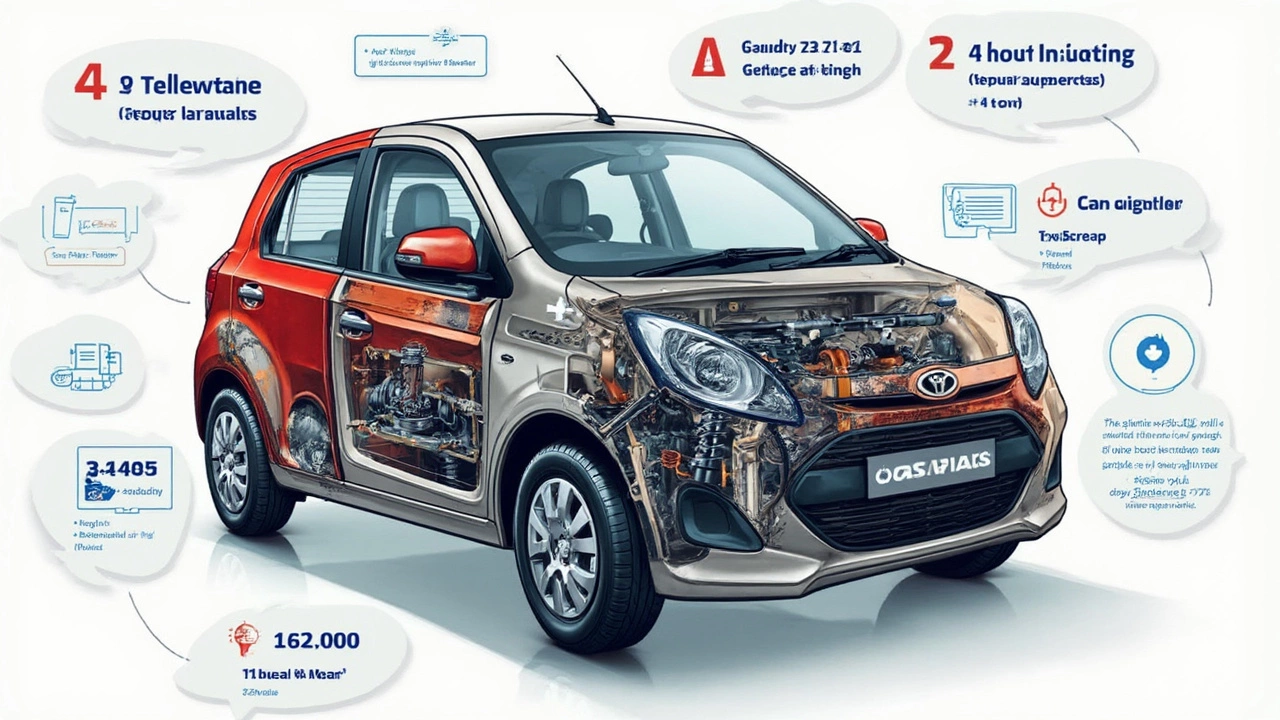 Jun, 26 2025
Jun, 26 2025
Bouncing down the street after hitting just one pothole? Odd squeaks and groans from somewhere under your car? That sinking feeling isn’t just in your stomach; it might be your suspension crying for help. Suspension damage can leave even the toughest trucks and family SUVs feeling wobbly, unpredictable, or downright dangerous. Still, most drivers keep rolling along, hoping the unsettling noises will vanish on their own. Bad news—they won’t. But here’s the twist: just because something’s broken doesn’t mean it’s the end of the road.
What Does Suspension Damage Really Mean?
Suspension isn’t one part; it’s a whole squad working together. Think about shocks, struts, coil springs, control arms, and bushings all joining forces to keep you from feeling every crack and bump. The system keeps your tires in contact with the road and helps your car handle corners, braking, and quick manoeuvres. When any of these parts start to give out, the difference isn’t subtle. The car might pull to one side, creak on turns, or ride more like an old mattress than a reliable ride.
Now, what kind of damage are we talking about? It’s sometimes dramatic—a snapped control arm after that surprise curb. Or maybe it creeps up over time, like bushings that soften and split. Not to mention pothole season here in Hamilton. Ontario’s frost heaves make it easy for lower control arms and shocks to take a beating. A friend once said Hamilton’s roads are really just obstacle courses for suspension systems.
According to research from CarMD’s 2024 Vehicle Health Index, about 3% of check engine lights in North America relate to suspension or steering issues. While it sounds tiny, that's thousands of breakdowns every year. Common causes include road salt (which eats away at metal parts and fasteners), hard impacts, and simple wear from time and mileage. Got a pick-up hauling drywall five days a week? Its suspension takes far more abuse than Grandma’s sedan.
The warning signs show up fast. The steering wheel may shudder or vibrate during turns. Your ride height could drop on one side. Tire wear might go from even to lopsided in just a few hundred kilometres. If you hear a clunk from the front end every time you brake, that’s likely a worn ball joint or bushing talking back.
Let’s clear up a big myth: suspension issues are more than a comfort problem. They hit safety, too. Problems like a broken spring or leaky shock don’t just ruin a smooth ride—they wreck your braking distance and steering response. The Insurance Institute for Highway Safety in the US actually found vehicles with poor suspension can need up to 20% more distance to stop (compared to the same car with healthy suspension parts). That difference could mean the world in a panic situation.
Can Suspension Damage Be Fixed?
If your mind jumps to an expensive fix or total part replacement, hang on. Not every suspension issue means shelling out for a whole new system. The fix depends on two things: what’s broken and how badly. For most drivers, the most common problems—worn shocks, leaking struts, split bushings—are fixable with parts swaps.
Let’s say you hit a nasty pothole and bend a control arm. Technicians won’t straighten it (that’d make it weaker). Instead, they swap in a new arm. Hungry squirrels gnaw through rubber boots protecting your ball joints? Replace the boots, not the entire joint, as long as sand and rust haven’t taken over. Got a spring that cracked from old age? Off with the old, on with a fresh coil.
Even big-sounding jobs, like replacing all four shocks on a crossover or swapping out control arms, aren’t as daunting as they sound for someone with the right tools. Service manuals or online videos make it possible for skilled DIYers to tackle straightforward repairs. Just don’t get cocky—springs are wound tight and can fire off with enough force to break an arm. The risk is real.
Sometimes, you’re looking at more than one part. It’s rare for a shock to fail alone—boots, mounts, and other bushings on the same corner might also be tired. A trusted shop will check all the components, not just the obvious one. For example, even a single bad bushing can mess up alignment and cause tire damage that adds up over time.
Here’s a quick breakdown of common repair choices and their ballpark costs (in CAD):
| Part | Typical Repair Cost (including labour, per corner) |
|---|---|
| Shock/Strut | $250 - $700 |
| Control Arm | $400 - $900 |
| Ball Joint | $250 - $500 |
| Spring | $300 - $600 |
| Bushing | $80 - $200 |
Keep in mind, on European cars or trucks with complex air suspensions, prices jump. And if an accident bent the suspension mounting points on the car frame, repairs get serious and might not always be worth it. Frame damage sometimes needs a body shop with special straightening tools.
On a positive note, when the damage is limited to the moving parts and not the structural frame, repairs can restore your ride to good as—or almost as—new. After repairs, always have your car’s alignment checked. Fresh parts can shift your geometry and send a car pulling or chewing through tires, even with everything else solid.

Spotting Trouble: How to Check for Suspension Damage
Most drivers notice suspension trouble in their wallets—unexplained tire wear, poor fuel economy, or constant steering corrections. But you don’t need to be a mechanic to spot early warning signs. Try this routine at least every oil change or after a whopper pothole:
- Bounce Test: With the car parked, push down hard on each corner. If it bounces more than once, chances are the shock or strut is worn.
- Uneven Tire Wear: Excessive wear on one edge or in cupped patterns usually points to worn bushings or bad alignment.
- Weird Noises: Clonks, groans, or squeaks when turning or hitting bumps mean something’s loose, cracked, or thirsty for grease.
- Visible Damage: Crawl under with a flashlight—look for dampness around shocks (a sign of leaks), split bushings, cracked springs, or rust.
- Steering Feel: Does the car pull, vibrate, or wander? Could be suspension, wheel alignment, or balancing trouble.
Winter in Ontario is tough on cars. Road salt quickly corroded unprotected metal bushings, especially on vehicles missing plastic shields or liners after an old fender bender. Hamilton’s endless freeze-thaw cycles can split boots and blow out rubber joints faster than you’d think. If your daily drive includes construction routes or unpaved alleys, double down on checks—these roads beat up cars even more.
When you spot trouble, don’t delay. A small issue like a worn bushing, if left alone, can stress and break nearby parts. Repairing one ball joint is a quick fix; leaving it too long could mean replacing the entire control arm or steering knuckle.
Is Suspension Repair Worth It?
No sugar-coating: suspension work isn’t always cheap. But driving with blown shocks or loose ball joints is kind of like eating soup with a fork. You might get by, but it’s not safe or smart. If you plan to keep your car for a few more years, swapping out bad parts is almost always worth the investment. It means better handling, better tire life, and less risk of bigger bills down the line.
Here’s a handy tip—double up repairs. If you replace one strut or shock, replace both on that axle for even handling. The same goes for bushings or ball joints, especially if they’re the same age. It costs a little more upfront but saves cash compared to repeating the same labour in a few months.
Can you live with just a little squeak or bounce? Maybe. But a Carfax analysis from 2023 found that cars with recent suspension repairs often sold for hundreds more than identical models with neglected suspension. If resale value matters—and let’s face it, it always does—fixing suspension problems pays off at trade-in time.
Keep in mind, specialty shops might push expensive upgrades (“loaded strut assemblies” or “performance shocks”) when standard parts will do. Stick to parts that match your driving: daily commute across the city calls for durable, reliable gear; spirited track runs or towing trailers might justify sturdier upgrades.
If you’re handy, suspension jobs can make great DIY projects and save you hundreds in labour. Just research your specific car. A Mazda3 might take two hours per corner, while a Ram 1500 might eat your whole weekend. YouTube and owner forums are goldmines for tricks and pitfalls. Always use a spring compressor when required, and don’t skimp on torque specs—loose parts can ruin all your hard work.
Thinking of waiting till “next season”? Consider this: a single bad shock can eat up two tires in less than 10,000 kilometres. Hamilton’s average cost for a new set of all-seasons is $600—almost the price of the repair itself. Plus, with parts in short supply (thanks, global shipping woes), waiting often means steeper bills and longer waits.
In a nutshell, suspension damage is one of those car headaches you shouldn’t ignore. The fix might be as easy as a bushing swap or as big as a coilover kit, but it beats wobbling around town and risking your safety. So if something feels off—or you’re just tired of being bounced around like a pinball—get it checked out before the bumps win.